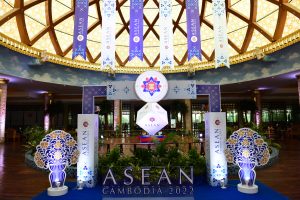The Association of South East Nations (ASEAN) has often been derided as a toothless tiger with little or no moral backbone, incapable of dealing with contentious issues like the military takeover in Myanmar or Chinese belligerence in the South China Sea.
But this year’s edition of the ASEAN Regional Forum was different. It will be remembered as a turning point, when commonsense prevailed amid the turbulence generated by a visit to Taiwan by U.S. House Speaker Nancy Pelosi.
The takeaway quotes that added some perspective came from Prak Sokhonn, the Cambodian foreign minister and host of this year’s summit, and his Russian counterpart, Sergey Lavrov. Prak Sokhonn said that “not even Superman can solve Myanmar’s problems,” while Lavrov, in his opening remarks, urged the Chinese foreign minister, Wang Yi, to “take no notice of the problems and crises created by Washington and hope for the best.”
Beijing did not heed the words from Moscow, declaring a live-fire zone on Taiwan’s east, firing rockets and deploying jets, overshadowing the more mundane issues – Myanmar aside – being discussed in Phnom Penh, such as post-COVID-19 economic recovery.
Wang cancelled talks with Japan and passed on a gala dinner with the nine ASEAN foreign ministers and another 30 or so from the bloc’s dialogue partners and observers.
China, looking every bit the school bully, was outplayed.
Ten years ago, when Cambodia last chaired ASEAN in 2012, no communique was issued for the first time in the group’s history, after it was scuttled by Phnom Penh. Cambodia was understood to be acting at China’s behest because of the draft communique’s references to disputes in the South China Sea. That created a furor and led to allegations that Cambodia had become China’s proxy within ASEAN in return for aid and investment.
But times have changed. Beijing’s largess in Cambodia is not what it was and an influx of well-documented Chinese criminals has soured relations with the local population.
Prime Minister Hun Sen, as chair of ASEAN, also tried to negotiate with the junta in Myanmar but made no progress on the five-point peace plan. Naypyidaw reneged on a promise to free Australian economist Sean Turnell and executed four democracy activists on the eve of the summit.
Those executions – the first in Myanmar in decades – had a chilling effect, were deeply offensive, and handed a troika formed by Indonesia, Malaysia, and Brunei the ammunition it needed to press for a much harsher and united response, which they got.
With Myanmar banned from attending summits, Prak Sokhonn began referring to the group as the ASEAN-9. It issued a 29-page communique – long by its standards – outlining a united approach to contentious issues that have split the bloc in recent years.
Myanmar is on notice while ASEAN considers its next move. That could include freezing all relations with the junta, recognition of the National Unity Government, formed by supporters of the ousted leader Aung San Suu Kyi, and sanctions.
There was nothing Myanmar’s only allies, Russia and – to a lesser extent – China, could do.
Beijing’s sole focus was its own creeping isolation in the South China Sea.
In the lead up to the summit, the Philippines made it clear it would assert the country’s maritime claims under a 2016 landmark ruling against China under the United Nations Convention on the Law of the Sea (UNCLOS). Beijing rejects the ruling.
The communique was explicit about land reclamations and the long history of “incidents” that had “eroded trust and confidence, increased tensions, and may undermine peace.” It was direct in stating UNCLOS’s “integrity needs to be maintained.”
Additionally, ASEAN repeatedly emphasized its centrality as a means of resolving disputes between major powers on the high seas, as opposed to the past 20 years of haggling with Beijing over a code of conduct. This was not what China wanted to hear.
Beijing is becoming increasingly isolated, partially through the Quad and an assertion by fed-up maritime ASEAN states like Indonesia and the Philippines. Its sphere of influence in the Indian and Pacific oceans has been hemmed in from South Korea in the northeast to India in its far southwest.
That puts the United States in the box seat.
ASEAN has struggled to find a cohesive response to the rapidly shifting regional dynamics, but that changed for the better at this summit.
With Myanmar, ASEAN recovered some of its lost moral fiber and a more united push on protecting international waters in the South China Sea earned much respect.
The final decisions about what comes next now rest with ASEAN leaders who will meet here in November when the nine countries will be expected to deliver on what their foreign ministers have recommended. A lively time ahead, no doubt.

































